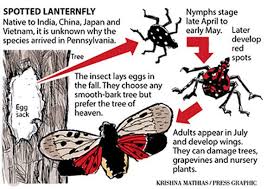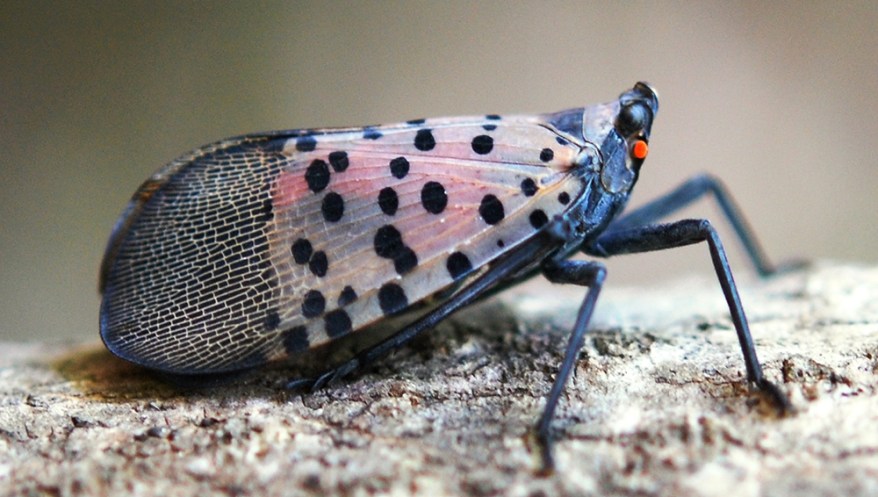Having been reported in 13 counties, including Northampton, it was only a matter of time before the invasive species known as the Spotted Lanternfly (SLF) was found in West Easton.
Early last week a friend sent me a picture of one she caught in Bangor and wondered if any were found in West Easton.
Until yesterday, I was able to say, “No.”
Yesterday, my neighbor killed a Spotted Lanternfly. They’re here. For those of us that grow vegetables, or have fruit trees, it is another problem.
It was first detected in September 2014 in Berks County, PA by the Pennsylvania Department of Agriculture and the Pennsylvania Game Commission and a quarantine zone was created. In three years the SLF quarantine zone has expanded to 6,900 square miles, and it was recently detected in Delaware and New York, becoming a regional and potentially national pest.
 Management strategies are needed to slow its spread to other regional fruit growing centers and to provide fruit growers with timely management tactics. This phloem-feeding Asian-native insect feeds upon over 65 species of plants and as such, is projected to become a serious pest of timber, ornamental trees, tree fruit orchards, grapes, stone fruit, and other small fruits such as blueberries.
Management strategies are needed to slow its spread to other regional fruit growing centers and to provide fruit growers with timely management tactics. This phloem-feeding Asian-native insect feeds upon over 65 species of plants and as such, is projected to become a serious pest of timber, ornamental trees, tree fruit orchards, grapes, stone fruit, and other small fruits such as blueberries.
It can kill hops and feeds on several types of vegetables. SLF honeydew (sugary SLF excrement) and sooty mold (growing on honeydew) damage were found in vineyards in 2016, only two years after first detection.
In 2017, extensive sooty mold growth was observed on and around forest trees, such as tree of heaven, willow, and maples, and blackening of adjacent plants in the forest understory.
Black walnut feeding caused yellowing and shocked trees into a general decline. SLF spread to more vineyards in 2017, reducing yield in one, and having as yet unknown long term effects on health of grapevines.
In late August, for the first time, large numbers of SLF were observed flying into and feeding on the trunks and branches of apple trees as well as nectarines and peaches. Immediate damage to tree fruit was not observed by the immigrating adults, but SLF egg cases found on the trees put the trees at risk for heavier and more sustained feeding by SLF nymphs and adults in Spring 2018.
As an invasive pest in South Korea, SLF spread rapidly and caused significant wilting, dieback and mortality of grape vines and spread throughout the country in only 3 years.
The Spotted Lanternfly can be controlled with contact poisons such as Sevin, Malathion, and Imidan. Though, the control is somewhat weaker toward SLF adults with some variability between products.
Of the organic products tested, Insecticidal Soap gave the best control, with Neem and Natria (sulfur and natural pyrethrin) being somewhat weaker.
You don’t need to spray or use insecticide should you see one. Step on it, swat it, or crush it with anything handy. They don’t bite or sting and should be treated like any other pest.
Disclaimer: On January 4, 2016, the owner of WestEastonPA.com began serving on the West Easton Council following an election. Postings and all content found on this website are the opinions of Matthew A. Dees and may not necessarily represent the opinion of the governing body for The Borough of West Easton.







